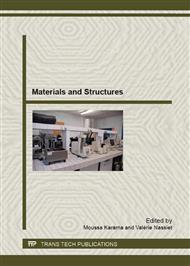[1]
W. P. Schmidt, H. M. Beyer, SAE Technical Paper 982195, Dec. (1998).
Google Scholar
[2]
C. Baley: Composites 33A, 939–948 (2002).
Google Scholar
[3]
H.CH.Spatz, L.Köhler et K.J. Niklas: J. of Exp. Biology, 202, pp.3269-3272 (1999).
Google Scholar
[4]
L.Köhler et H.C. Spatz. Planta, 215, pp.33-40 (2002).
Google Scholar
[5]
Broutman L. J. , Sahu S. : Composites Materials, ASTM STP, 170-188, (1972).
Google Scholar
[6]
Ph. Boisse, B. Zouari, A. Gasser. Composites Science and Technology 65 (2005) 429–436.
Google Scholar
[7]
Kawabata S., Niwa M., and Kawai H. J. Textile Inst., 64, 1, 1973, pp.21-46.
Google Scholar
[8]
J. Gassan, I. Mildner, and A. K. Bledzki : Mechanics of Comp. Materials, Vol. 35/ 5, 1999.
Google Scholar
[9]
K. Chaudhuri, M.A. Chaudhuri Biologia plantarum 40 (3) 373-380 1998.
Google Scholar
[10]
HEARLE (J.W.S.). Journal of Applied Polymers Science, 7, pp.1207-1223 (1963).
Google Scholar
[11]
R. Rao, N. Balas. And J. Chanda.. App. Poly. Sci. Engg., 26, p.9069 (1981)
Google Scholar
[12]
S.K. Garkhail, , R.W.H. Heijenrath, , T. Peijs. Appl. Compos. Mater. 7, 351–372 (2000).
Google Scholar
[13]
D. Ray, BK. Sarkar, S. Das, AK. Rana. Compos Sci Technol 2002; 62:911–7.
Google Scholar
[14]
LY. Mwaikambo, Ansell MP. Compos Sci Technol 2003; 63:1297–305.
Google Scholar
[15]
Khan MA, Mina F, Drzal LT. 3rd int. wood and natural fibre composite symposium, 2000.
Google Scholar
[16]
J. Gassan, AK. Bledzki. Polym Composites 1999;20 (4):604–11.
Google Scholar
[17]
LA. Pothan, S. Thomas. Compos Sci Technol 2003;63:1231–40.
Google Scholar
[18]
PJ Herrera-Franco, A. Valadez-Gonzales. Composites Part A 2004;35:339–45.
Google Scholar
[19]
MA Khan, MM Rahman, KS.Akhunzada. Polym Plast Tech Eng 2002;41(4):677–89.
Google Scholar
[20]
M Masudul Hassan, Islam MR, Khan MA. J Adhes Sci Technol 2003;17(5):737–50.
Google Scholar
[21]
D. Plackett and A. Vázquez. Woodhead Publishers, Cambridge 2004, p.123.
Google Scholar
[22]
M. A Khan. ; N. Haque; A. Al-Kafi ; M. N. Alam; M. Z. Abedin ISSN 0360-2559 CODEN PPTEC7. 2006, vol. 45, 4-6, pp.607-613.
Google Scholar
[23]
R. G. Raj, B. V. Kokta and C. Daneault. J. of Materials Science, 1990, 25, 1851-1855.
Google Scholar
[24]
D. Harper and M. Wolcott. Comp. Part A: Applied Sci. and Manuf. 35, (2004), 385-394.
Google Scholar
[25]
I. Aranberri, T. Lampke and A. Bismarck. J. of Colloid and Interf. Sci.2003, 263 (580-589)
Google Scholar
[26]
A. Karmarkar, S. Chauhan, M. Modak, M. Chanda. Comp. Part A: (2007), 38 (2), 227-233.
Google Scholar
[27]
J. B. Naik; S. Mishra. C. Polymer-Plastics Techno. and engineering 46, 2007, 537 – 540.
Google Scholar
[28]
Sy Trek Sean. Technology and engineering (2007), 46(4), 421 – 425.
Google Scholar
[29]
T. Keener, R.Stuart, T.Brown. C. Part A: Applied S. and Manuf. (2004), 35 (3), 357-363.
Google Scholar
[30]
H. Jiang, D. P. Kamdem. Journal of Vinyl and Additive Technology, (2004), 10 (2), 59-69.
Google Scholar
[31]
K. Sabeel Ahmed, S.Viyayarangan. J. of mat. processing technology 207 2008 330-335.
Google Scholar
[32]
K. Sabeel A, S.Viyayarangan and C. Rajput. J. of reinforced plastics and comp. In press
Google Scholar
[33]
D. Placketta, T. Løgstrup , W. Batsberg, L. Nielsenc. C. Sci. and T. 63 2003 1287–1296.
Google Scholar
[34]
Martina Wollerdorfer, Herbert Bader. Industrial Crops and Products 8 (1998) 105–112.
Google Scholar
[35]
K. Van de Velde, P. Kiekens, Biopolymers. Polymer Testing 21 (2002) 433–442.
DOI: 10.1016/s0142-9418(01)00107-6
Google Scholar
[36]
V. Alvarez, E. Rodriguez, A. Vázquez. J. of Thermal A. and Calori. 85 2006 2, 383–389.
Google Scholar
[37]
C. Hong, I. Hwang, N. Kim, D. Park, B. Hwang, C. Nah. J. of Ind. and Engineering Chemistry 14 (2008) 71-76.
Google Scholar


